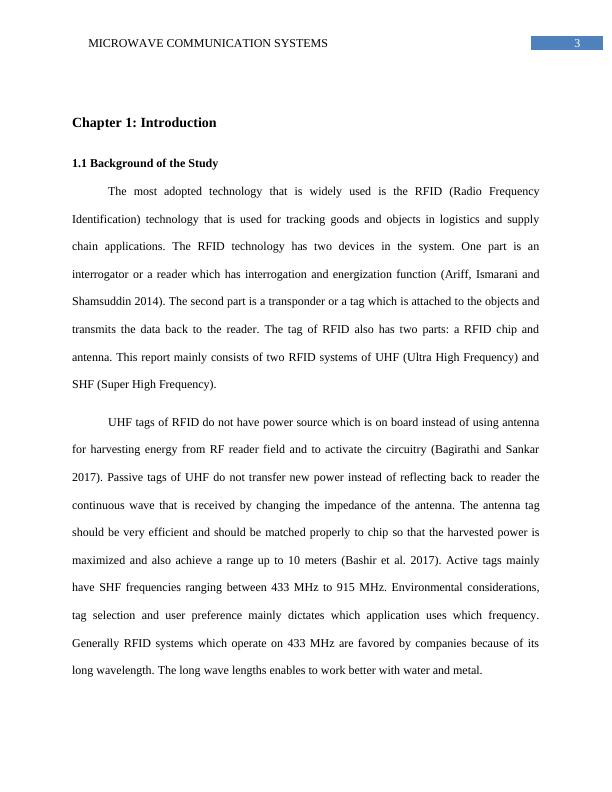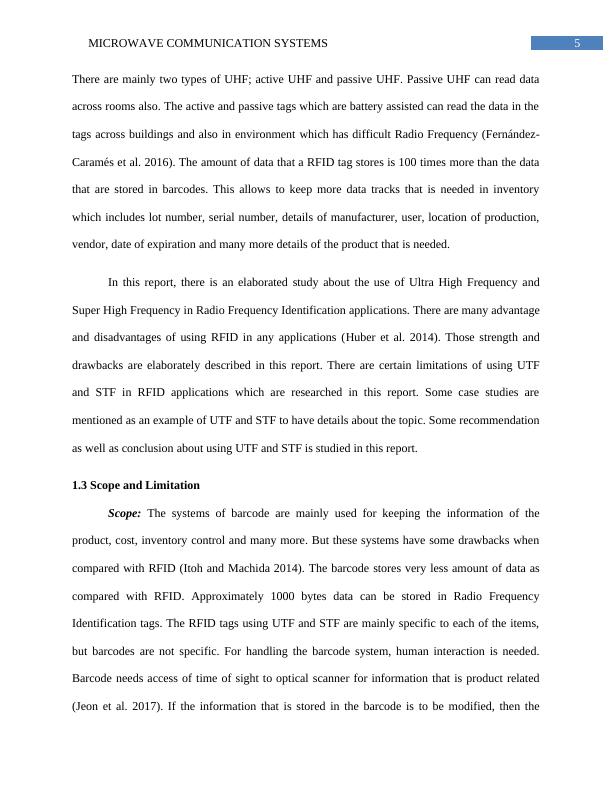Ask a question from expert
ELEC 30005 : Microwave communication systems
24 Pages6013 Words188 Views
Microwave communication systems (ELEC 30005)
Added on 2020-04-21
ELEC 30005 : Microwave communication systems
Microwave communication systems (ELEC 30005)
Added on 2020-04-21
BookmarkShareRelated Documents
Running head: MICROWAVE COMMUNICATION SYSTEMS Microwave Communication SystemsName of Student-Name of University-Author Note-

1MICROWAVE COMMUNICATION SYSTEMSAbstractThe devices with Radio Frequency Identification have a small antenna and chip. The chip that isused in RFID usually has a capability to carry 2000 bytes or less data in them. The work of RFIDis same as the barcode or same as the magnetic strip that is present in the back of an ATM cardor a credit card. The RFID tag provides an identifier that is unique for the object that it works on.Same like barcodes and magnetic strips are scanned to get all the information, the tag f RFID isalso scanned so that the information can be identified. There are many advantages of usingUpper High Frequency and Super High Frequency in RFID. RFID has an advantage that they canbe placed precisely along with the scanner. The RFID reader and tags can be handled easilywhich is not the case in magnetic tape and barcode scanner. This report presents a detail structureof RFID device with a case study of UHF and SHF.

2MICROWAVE COMMUNICATION SYSTEMSTable of ContentsAbstract................................................................................................................................1Chapter 1: Introduction........................................................................................................21.1 Background of the Study...........................................................................................21.2 The Rationale.............................................................................................................31.3 Scope and Limitation.................................................................................................4Chapter 2: Discussion..........................................................................................................62.1 Block Diagram...........................................................................................................62.2 System Implementation and Types............................................................................82.3 Strengths..................................................................................................................122.4 Drawbacks...............................................................................................................122.5 Comparison..............................................................................................................13Chapter 3: Results of Research..........................................................................................143.1 Findings...................................................................................................................143.2 Conclusion...............................................................................................................153.3 Recommendation.....................................................................................................16References..........................................................................................................................17

3MICROWAVE COMMUNICATION SYSTEMSChapter 1: Introduction1.1 Background of the StudyThe most adopted technology that is widely used is the RFID (Radio FrequencyIdentification) technology that is used for tracking goods and objects in logistics and supplychain applications. The RFID technology has two devices in the system. One part is aninterrogator or a reader which has interrogation and energization function (Ariff, Ismarani andShamsuddin 2014). The second part is a transponder or a tag which is attached to the objects andtransmits the data back to the reader. The tag of RFID also has two parts: a RFID chip andantenna. This report mainly consists of two RFID systems of UHF (Ultra High Frequency) andSHF (Super High Frequency). UHF tags of RFID do not have power source which is on board instead of using antennafor harvesting energy from RF reader field and to activate the circuitry (Bagirathi and Sankar2017). Passive tags of UHF do not transfer new power instead of reflecting back to reader thecontinuous wave that is received by changing the impedance of the antenna. The antenna tagshould be very efficient and should be matched properly to chip so that the harvested power ismaximized and also achieve a range up to 10 meters (Bashir et al. 2017). Active tags mainlyhave SHF frequencies ranging between 433 MHz to 915 MHz. Environmental considerations,tag selection and user preference mainly dictates which application uses which frequency.Generally RFID systems which operate on 433 MHz are favored by companies because of itslong wavelength. The long wave lengths enables to work better with water and metal.

4MICROWAVE COMMUNICATION SYSTEMSIn this digitization era, the use of Radio Frequency Identification (RFID) is fast growingbecause it has many advantages with comparison to Auto-IDs. As discussed above, the system ofRFID has two parts known as tag and the reader (Bibi et al. 2017). The main function of theRFID system is to retrieve all the information automatically with the help of reader which isstored in the tag previously. There are also some limitations of using RFID tag as the tags havesingle antenna which is used for backscattering and receiving (Chambe et al. 2014). The chipthat is present in the tag changes the impedance between the complex values and short circuitvalue which modulates the signal that is back scatterer according to which the information isstored inside the chip alternatively. The antenna does not receive any kind of power from reader during short circuit (Dakir etal. 2017). For this reason, the efficiency of energy absorption continues to drop significantly.Two impedance short circuit and the conjugate matched in the short circuit phase, the status willnot provide maximum difference in impedance in backscattered signals that results in read thesignals in shorter range. This problem of RFID has also been mitigated. The process of shortcircuit is mitigated by implementing dual structure of antenna. In a single RFID chip, a dualantenna structure is incorporated (Donno, Catarinucci and Tarricone 2014). With theincorporation of dual antenna, all the signals are utilized for backscattering and receiving theoperations separately. In many of the antennas of RFID tags, UHF (Ultra High Frequency) andSHF (Super High Frequency) bands are proposed (Ding et al. 2014). In some of the systems,convectional antennas that are single are used and others uses dual antenna. 1.2 The RationaleThe most significant advantage of Radio Frequency Identification using UHF and SHF isthat they can uses dual structure of antenna which allows the signal to read data from far away.

5MICROWAVE COMMUNICATION SYSTEMSThere are mainly two types of UHF; active UHF and passive UHF. Passive UHF can read dataacross rooms also. The active and passive tags which are battery assisted can read the data in thetags across buildings and also in environment which has difficult Radio Frequency (Fernández-Caramés et al. 2016). The amount of data that a RFID tag stores is 100 times more than the datathat are stored in barcodes. This allows to keep more data tracks that is needed in inventorywhich includes lot number, serial number, details of manufacturer, user, location of production,vendor, date of expiration and many more details of the product that is needed. In this report, there is an elaborated study about the use of Ultra High Frequency andSuper High Frequency in Radio Frequency Identification applications. There are many advantageand disadvantages of using RFID in any applications (Huber et al. 2014). Those strength anddrawbacks are elaborately described in this report. There are certain limitations of using UTFand STF in RFID applications which are researched in this report. Some case studies arementioned as an example of UTF and STF to have details about the topic. Some recommendationas well as conclusion about using UTF and STF is studied in this report. 1.3 Scope and LimitationScope: The systems of barcode are mainly used for keeping the information of theproduct, cost, inventory control and many more. But these systems have some drawbacks whencompared with RFID (Itoh and Machida 2014). The barcode stores very less amount of data ascompared with RFID. Approximately 1000 bytes data can be stored in Radio FrequencyIdentification tags. The RFID tags using UTF and STF are mainly specific to each of the items,but barcodes are not specific. For handling the barcode system, human interaction is needed.Barcode needs access of time of sight to optical scanner for information that is product related(Jeon et al. 2017). If the information that is stored in the barcode is to be modified, then the

End of preview
Want to access all the pages? Upload your documents or become a member.
Related Documents
Reconfigurable RFID Antennas and Applicationslg...
|5
|3515
|443
Study on Radio Frequency Identificationlg...
|11
|2382
|328
Smart Cards: RFID, Security, and Implementationlg...
|38
|8487
|390
Working of RFID and NFC: Current Security Considerations and Challengeslg...
|4
|662
|401
Wireless Communication Protocols for Internet of Things (IoT)lg...
|10
|902
|363